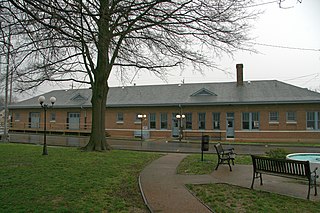
Newbern Depot, also known as Newbern Illinois Central Depot or as the Newbern–Dyersburg station, is an Amtrak station and museum in Newbern, Tennessee. It is an unstaffed flag stop on the City of New Orleans route, which serves Newbern and nearby Dyersburg when passengers have tickets to and from the station. The building was constructed by Illinois Central Railroad in 1920 and was added to the National Register of Historic Places in 1993.
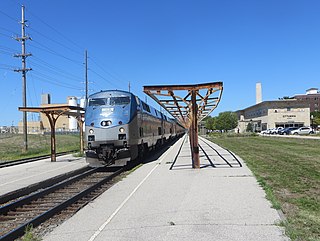
Ottumwa station is an Amtrak intercity train station in Ottumwa, Iowa, United States. The station was originally built by the Chicago, Burlington and Quincy Railroad, and has been listed as Burlington Depot by the National Register of Historic Places since November 26, 2008. It became a contributing property in the Historic Railroad District in 2011.

The Atchison, Topeka and Santa Fe Passenger and Freight Complex is a nationally recognized historic district located in Fort Madison, Iowa, United States. It was listed on the National Register of Historic Places in 1992. At the time of its nomination it contained three resources, all of which are contributing buildings. The buildings were constructed over a 24-year time period, and reflect the styles that were popular when they were built. The facility currently houses a local history museum, and after renovations a portion of it was converted back to a passenger train depot for Amtrak, which opened on December 15, 2021.

The Chicago, Milwaukee, St. Paul and Pacific Railroad Depot and Lunchroom are two buildings located in Wells, Minnesota, and built by the Chicago, Milwaukee, St. Paul and Pacific Railroad in 1903.

Columbia station is a historic train station and headquarters of Columbia Transit located in Columbia, Missouri. The building was constructed in 1909 as the terminus of the Columbia Branch of the Wabash Railroad. It is a one-story, H plan, Tudor Revival style building constructed of locally quarried rock faced ashlar cut stone. In 2007, the building underwent renovation and restoration and was expanded to accommodate offices for Columbia's public transportation. The project, costing over $2.5 million, was intended to make the station a multi-model transportation center. It was certified at the LEED Silver Level, meaning it meets national standards for energy efficiency and sustainable construction. The station is the busiest bus stop in Columbia and served as a pickup point for Megabus until September of 2015.

Chicago, Rock Island and Pacific Railroad-Wilton Depot is an historic building located in Wilton, Iowa, United States. The Mississippi and Missouri Railroad built the first rail line in 1855 in what would be called Wilton Junction. The railroad became the Chicago, Rock Island and Pacific Railroad (CRI&P) a few years later. A wooden frame depot and a separate freight facility served the community. The railroad placed their repair and maintenance center in Wilton, and it remained here until 1881 when they started to move operations to Davenport and Muscatine. Rail service continued to increase along the CRI&P, which necessitated a new depot in Wilton. This single-story, brick Romanesque Revival structure was completed in 1898. Six passenger trains stopped in Wilton in 1911, and by 1922 same-day service to and from Chicago began.
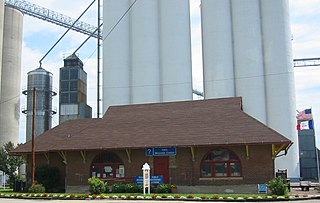
Burlington, Cedar Rapids & Northern Passenger Depot-Dows, also known as the Dows Rock Island Depot, is an historic building located in Dows, Iowa, United States. The depot was built in 1896 and served the Burlington, Cedar Rapids and Northern Railway as a combination passenger and freight station. The Romanesque Revival style was inspired by Henry Hobson Richardson's designs for small railroad stations. It was the first railway depot in Wright County. It passed to the Chicago, Rock Island and Pacific Railroad and continued to serve as a working depot until 1980. The Dows Historical Society bought and restored the depot in 1988. It now serves as a welcome center and railroad museum. It was listed on the National Register of Historic Places in 1993.
The Chicago and North Western Passenger Depot is a historic building located in Wall Lake, Iowa, United States. Wall Lake was served by both the Chicago & North Western Railroad and the Illinois Central Railroad, which gave it a significant rail presence from the 1880s until World War II. The C&NW depot is an example of a combination station plan. The plan combined both passenger and freight services in one building. They were commonly used during the heyday of railroad growth round the turn of the 20th century. However, the old Wall Lake C&NW depot was moved and used for freight. What would have been the freight room was used here for a lunchroom. C&NW had three standard combination depot plans that have been attributed to the prominent Chicago architectural firm of Frost & Granger. The Wall Lake depot was the largest of the three as it incorporated a women's waiting room, but it was actually 9 feet (2.7 m) shorter than the general plan because freight was processed in another facility. The depot was built in 1899 by A.H. Carter & Co. of Cedar Rapids, Iowa as a replacement depot. The single-story frame structure is the only building used as a depot that remains in town. It was listed on the National Register of Historic Places in 2003.

Keokuk Union Depot is an historic train station on the west bank of the Mississippi River near downtown Keokuk, Iowa, United States. It was built from 1890 to 1891, and it was listed on the National Register of Historic Places in 2013.

Wabash Combination Depot-Shenandoah, also known as the Shenandoah Wabash Depot, is an historic building located in Shenandoah, Iowa, United States. The depot was built in 1903, and replaced a smaller and older structure. It was designed by and served the Wabash Railroad as a combination passenger and freight station. The Queen Anne and Stick-Eastlake style station was a standard design used by the railroad. The single-story, frame structure features a gabled roof and wide, overhanging eaves. It was an island station that sat in the midst of the tracks. The rear track was used for loading and unloading freight, while the main line rails were along the front. The depot was acquired by the Wabash Trace Nature Trail from the Iowa Southern Railway. The Wabash Trace relocated it to Sportsman's Park in Shenandoah, along the Burlington Northern tracks. The depot was listed on the National Register of Historic Places in 1990.

The Chicago, Milwaukee & St. Paul Depot-Jefferson, also known simply as the Milwaukee Depot is an historic building located in Jefferson, Iowa, United States. The rail line that this station served was built by the Wabash, St. Louis and Pacific Railway in either 1882 or 1883. It was part of the 500 miles (800 km) of track developed by Jay Gould in Iowa. Known as the High Bridge Route because of the height of the bridge over the Des Moines River, it was acquired by the Des Moines, Northern and Western Railroad in 1891. Four years later the Chicago, Milwaukee and St. Paul Railway acquired the line. The Milwaukee Road built this train station from their standard building plan between 1906 and 1909. It is almost identical to the station built in 1906 in Adel, Iowa. This passenger station replaced a combination passenger and freight depot that was moved and used solely as a freight depot. The Milwaukee Road discontinued passenger service in Jefferson in the early 1950s, and the depot continued as a freight office until 1980. The building was listed on the National Register of Historic Places in 1994.
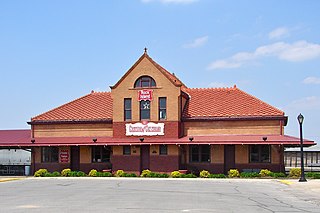
The Chicago, Rock Island & Pacific Railroad Depot, also known as the Rock Island Depot, is an historic building located in Atlantic, Iowa, United States. The Chicago, Rock Island & Pacific Railroad built the first tracks through the area in 1868. The city of Atlantic was founded at the time of the railroad construction. It grew to become the largest and the most significant community along the Rock Island lines between Des Moines and Council Bluffs. The present depot dates from 1898, and it is not a standard-plan depot for the railroad. The unusual design suggests it is the work of an architect, possibly from Chicago. It was built during a prosperous period for the railroad when it was able to replace its facilities along its mainline. The express freight and baggage building attached to the depot was built at the same time. The passenger depot replaced a frame combination passenger and freight depot a block away.
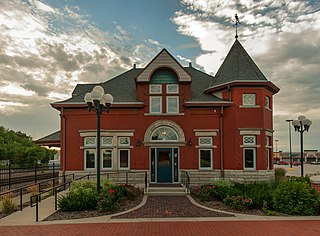
The Chicago & Northwestern Passenger Depot and Baggage Room-Carroll, also known as the Carroll Depot is a historic building located in Carroll, Iowa, United States. It is an example of a replacement station built along its Iowa mainline by the Chicago and North Western Railway (CNW) in 1896. It replaced a two-story, frame, combination station that was first built in 1867 by its predecessor line, the Cedar Rapids and Missouri River Railroad. That building had experienced two fires. The CNW had built two branch lines from Carroll in 1877 and 1880, which increased business and necessitated a larger depot. The Carroll Express Building was also built across the street for further railroad use. A separate wooden freight house had been built in 1888. Chicago architect Charles Sumner Frost designed this station in the Romanesque Revival style. The baggage room is separated from the depot by a breezeway. Frost designed at least 15 stations for the CNW in Iowa and Nebraska and another 14 in the Chicago area. The building represents the prosperity of the line during the Golden Age of Railroads.

The Chicago, Milwaukee & St. Paul Narrow Gauge Depot-LaMotte is a historic building formerly located in La Motte, Iowa, United States. The Chicago, Bellevue, Cascade & Western Railroad was incorporated in August 1877, to build a narrow-gauge railway from Bellevue to Cascade. Narrow-gauge was chosen because it was cheaper to build, and it could negotiate the tight turns on the rugged terrain better. Construction began the following year, but lack of money doomed the project. The Chicago, Clinton, Dubuque and Minnesota Railroad took over the project, and it was completed on December 30, 1879. The first train reached Cascade on January 1, 1880. Ten months later they sold all their holdings to the Chicago, Milwaukee & St. Paul Railroad, and this line became a branch line of the Milwaukee Road. That same year a frame depot was built in La Motte. It served as a combination freight and passenger station until it was destroyed by fire in 1910. This depot replaced it the following year. The 1½-story frame combination station represents the corporate style and standardized practices of the Milwaukee Road. However, it reflects the depots they built in the late 19th century, so it was somewhat outdated when it was built.

The Chicago, Rock Island and Pacific Passenger Depot-Pella, also known as the Pella Depot and the Rolscreen Museum, is a historic building located in Pella, Iowa, United States. The Des Moines Valley Railroad built the first tracks through the area in 1865, and they built a simple frame depot to serve passenger's needs. For 10 years, Pella served as the only rail stop in Marion County until a competing station was built in Knoxville, Iowa by the Chicago, Burlington, and Quincy Railroad. The Chicago, Rock Island & Pacific Railroad leased the Des Moines Valley's tracks beginning in 1878 and provided freight service through 1980. The old frame building was replaced, in 1906, with a single story, brick depot–a conventional building style for the railroad. The new, brick depot served as a passenger station until the latter 1940s. The last passenger service was as a stop on a short line motor train service between Eldon in southeast Iowa and Des Moines. The station was freight only by 1949.

The Sac City Chicago and North Western Depot is a historic building located in Sac City, Iowa, United States. The city was platted in 1855, and soon after they began to campaign for a rail line into the town. It took 23 years before the railroad arrived. The Maple River Railroad was the first to lay tracks in Sac County in 1877, but it went to Wall Lake rather than Sac City. The Sac City & Wall Lake Railroad was formed that year and the tracks were laid between the two towns in 1878. The Chicago & North Western Railroad acquired the line in 1884, and built a two-story frame depot in Sac City. The business district grew up around the depot. In 1916 the Chicago & North Western replaced the frame depot with this single story brick depot a block to the south. It was a combination depot, passenger and freight, that utilized Chicago & North Western's Number One standard plan.
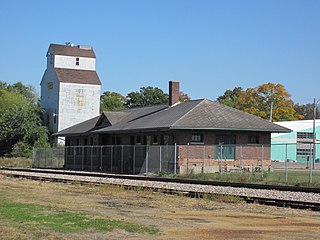
Illinois Central Combination Depot-Ackley is a historic building located in Ackley, Iowa, United States. The Dubuque & Sioux City Railroad, an affiliate of the Illinois Central Railroad (IC), laid the first rail track to Iowa Falls in 1865. Two years later the Iowa Falls & Sioux City Railroad, another IC affiliate, continued construction of the line to the west, and it reached Sioux City by 1870. They built a plain, two-story frame depot to serve Ackley. From the 1890s to the 1920s the IC replaced its first generation stations with new brick structures. IC architect J.H. Schott designed the new depot at Ackley, and it was built by Coomer & Small Construction Company of Sioux City. The long and low single-story brick building exhibits influences from the Prairie School and the Tudor Revival style. A combination depot is one that incorporates passenger and freight services in the same building. It was also an island depot, meaning that it sat in the middle of the tracks. It was one of the last replacement depots the IC built before the Great Depression. The building was listed on the National Register of Historic Places in 1990.
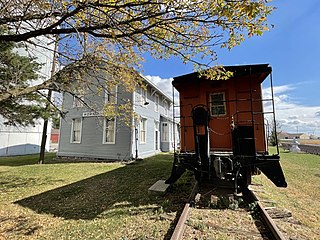
The Chicago, Milwaukee, St. Paul & Pacific Combination Depot-Hornick, also known as the Hornick Depot, is a historic building located in Hornick, Iowa, United States. The town was patted by the Chicago, Milwaukee, St. Paul & Pacific Railroad's land company when the railroad created a branch line from Manilla, Iowa to Sioux City. Completed in 1887, the railroad built this two-story frame structure to serve as its passenger and freight depot. It is one of six such depots that remain in Iowa, and the best preserved. These buildings were built from a standard design used by the railroad. The two-story stations included living quarters for the station manager because the towns had yet to develop when the depot was built. This was an island depot, with freight loaded on the north side and passengers boarded on the south. Decorative elements on this depot include lathe-turned wooden finials, angled wooden brackets, and bracketed door and window hoods. Passenger service ended in the 1950s, and grain was loaded here until 1980 when the Milwaukee Road abandoned the Sioux City branch line. The building was listed on the National Register of Historic Places in 1990. It has been converted into a local history museum.
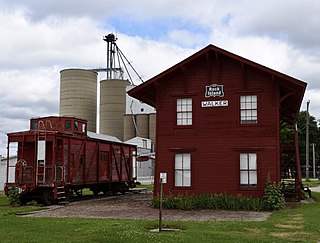
Walker Station is a historic building located in Walker, Iowa, United States. The two-story frame building with bracketed eaves was completed in 1873 along the Burlington, Cedar Rapids, and Minnesota Railway tracks. The depot also served its successor railroads: the Burlington, Cedar Rapids and Northern, and the Chicago, Rock Island and Pacific. Typical of many railroad towns in the Midwest, this is the first building that was built here and the town grew up around it. It is an example of a combination depot that was used for both passenger and freight usage in smaller communities. Because it has a ground level brick platform, service here was primary passenger and light freight service. A higher level of freight service would have required a raised platform.

The Milwaukee and St. Paul Railway Combination Depot is a historic building located in Decorah, Iowa, United States. After the Milwaukee and St. Paul Railroad, later the Chicago, Milwaukee, St. Paul and Pacific Railroad, choose a different route for their north–south mainline, community leaders convinced them to build a spur to Decorah. This would open the town to larger markets to ship the products produced there. The tracks were completed in 1869, and a boxcar served as the first depot. That same year this single-story, wood-frame structure with Greek Revival features was completed south of the central business district. It served as a combination depot, servicing both passengers and freight. After the arrival of the Chicago, Rock Island and Pacific Railroad in 1884 the Milwaukee Road started to plan a new passenger depot in Decorah. It was completed on the east end of the main commercial street in 1888. When it opened, this building continued to serve as a freight depot. Over the years its platforms were shortened, and sometime between the 1930s and the 1950s, the southwest end of the building was shortened. The Milwaukee Road abandoned the depot in 1971, and the tracks that flanked the building were removed the same year. The former depot itself was renovated for non-railroad use. This is believed to be a rare extant example of a wooden combination depot in Iowa. The building was listed on the National Register of Historic Places in 2016.






















